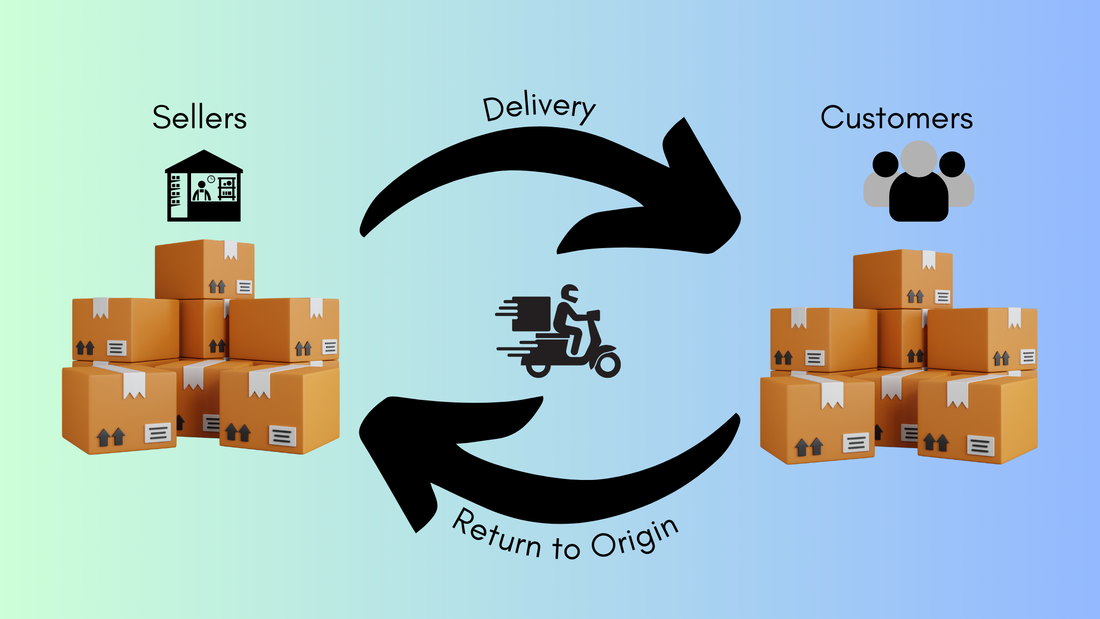
Understanding RTO Returns in Ecommerce
What is RTO in E-commerce?
RTO (Return to Origin) happens when an online order is not delivered to the customer and is sent back to the seller. This is a big problem in e-commerce, especially in India. RTO increases costs for businesses and affects both customers and sellers.
Let’s look at the main reasons for RTO in e-commerce and why it is a serious issue.
1. Customers Ordering by Mistake
Many customers place orders by mistake or say that their family members, such as a brother or child, ordered without their knowledge. In such cases, when they refuse the delivery, it results in an RTO. This causes direct financial loss to the seller, as the order has already been packed and shipped.
2. Fake Delivery Attempts
Sometimes, delivery agents mark an order as undelivered even when they never visit the customer's address. This is called a fake delivery attempt. It can happen due to high work pressure, laziness, or even fraud. As a result, the order is returned to the seller, increasing RTO rates.
3. Delivery Boy Fraud
In some cases, delivery personnel may intentionally report an order as undelivered. This could be to earn extra commissions on multiple attempts or even to steal the product. Such fraud leads to unnecessary RTOs, causing losses for e-commerce businesses.
4. Negative Impact on Customer Record
When a customer’s order gets returned due to RTO, it gets recorded in the seller's system. If a customer frequently fails to receive orders, sellers might avoid delivering to them in the future. This means that even if the customer genuinely wants to buy something next time, they may not get the delivery.
5. Shipping Cost Loss
Every RTO means that the seller has already paid for shipping charges. Shipping costs are non-refundable, and when an order is returned, the seller loses money on both forward and return shipping.
6. Packaging Cost Loss
Before shipping, sellers spend money on packing materials like boxes, tapes, and bubble wraps. When an order is returned due to RTO, all these materials go to waste, leading to unnecessary losses.
Challenges in the Logistics Industry
The logistics industry faces several challenges that impact e-commerce and delivery efficiency:
- High RTO Rates: Frequent returns lead to increased costs for sellers and logistics providers.
- Last-Mile Delivery Issues: Traffic congestion, inaccurate addresses, and delivery refusals make last-mile delivery difficult.
- Fraud and Theft: Fake delivery attempts and product thefts by delivery personnel lead to financial losses.
- High Shipping Costs: Rising fuel prices and operational expenses increase the overall shipping cost.
- Customer Unavailability: Many orders fail due to customers not being available at the time of delivery, leading to more RTO cases.
- Delivery Boy Fraud: Some delivery personnel commit fraud by falsely marking deliveries as failed or stealing products. Logistics companies must take strict measures like background checks, GPS tracking, and performance monitoring to prevent such issues and improve delivery quality.
Pain Areas in E-commerce: Customers vs. Logistics Actions
| Pain Area |
Customer Actions |
Logistics Actions |
| Fake Delivery Attempts |
No action was taken by the customer |
The delivery agent falsely marks the order as undelivered |
| Delivery Boy Fraud |
The customer does not receive the package |
Delivery personnel may steal the product or claim non-delivery fraudulently |
| High RTO Rates |
Customer refuses delivery or is unavailable |
Logistics incurs costs on return shipping |
| Shipping Cost Loss |
No action needed |
Seller pays for both forward and return shipping |
| Packaging Cost Loss |
No action needed |
The seller loses money on packaging materials |
| Customer Trust Issues |
The customer's record gets flagged |
Future orders from flagged customers may be denied |
Responsible Buying and Logistics Verification
Many e-commerce business owners suffer because of unnecessary RTOs. Customers should only place an order if they are sure about their purchase. If they have doubts, they should contact customer care before confirming the order. Unnecessary returns not only increase costs but also create a negative shopping history for the customer, which might impact future deliveries. Every online business owner faces this issue, and reducing RTO can help them provide better services at lower costs.
Additionally, logistics companies must take responsibility for preventing fraudulent activities. If an order is falsely marked as undelivered or if delivery personnel commit fraud, logistics companies should have verification processes in place. GPS tracking, delivery OTP verification, and stronger background checks can help prevent such issues. When a package is returned, the seller incurs a complete loss because packaging materials like boxes and tapes are not reusable, leading to wasted money and resources. Moreover, wastages of packaging materials such as shipping labels and other accessories will also impact the environment. A more reliable logistics system can help ecommerce sellers avoid these unnecessary expenses and improve customer satisfaction.
Proactive Communication and Fraud Prevention
- Pre-order Confirmations: Businesses should confirm COD orders via call, SMS, or email before shipping to prevent accidental or fraudulent orders.
- Customer Education: Informing customers about the impact of RTO can help reduce unnecessary returns.
- Blocklist Fraudulent Customers: Sellers should maintain records of customers who frequently refuse deliveries and block them from placing future orders.
- Monitor Delivery Personnel: Logistics providers should take strict actions against delivery fraud, ensuring that delivery attempts are genuine.
Conclusion
RTO in India is a major challenge for e-commerce businesses. It leads to fake delivery attempts, fraud, and financial losses and impacts future purchases. By ensuring accurate customer data, optimizing product listings, improving delivery quality, offering convenient return policies, and preventing fraud, sellers can effectively reduce RTO rates and improve their business profits.

